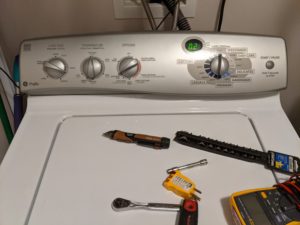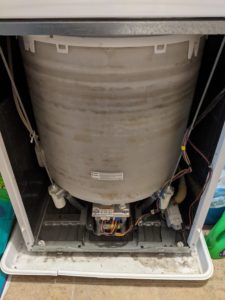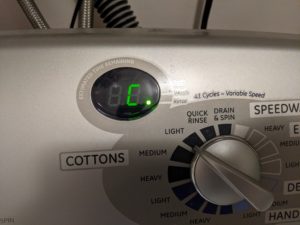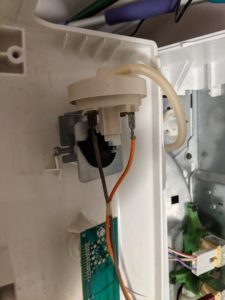My GE Profile (I think… model WPRE8150H1WT) washer decided to stop spinning out the load. Otherwise, it would work correctly. After checking for obvious stuff (unbalanced/heavy load, pump failure, etc), I looked into it and ultimately fixed it for free.

Troubleshooting Steps
Obviously, with some of the below steps, checking after is necessary.
- Unplug the Washer for a Minute
This is effectively a reboot. It has a microcontroller or something on it to tell it what to do, and the first step is to reboot. - Reset the Motor Controller
According to GE on YouTube, you can reset the motor controller by doing a reboot (unplug for a minute) and then open/close the lid 6 times in 30 seconds. - Check the Motor
The motor is front-center-low on the washer. You can remove the front panel by using a putty knife to disengage some clips at the top and it tilts out. The motor has a light on it that should be flashing in a regular pattern. If it is not, it will blink a pattern and repeat it every six seconds. Check the service manual (do a web search for it) for what the pattern means. - Enter Field Service Mode to Check Things
This is done by holding down the button and turning the mode switch half a turn (don’t go too fast, it needs to register each click) and releasing the button. You did it correctly if the display goes to 88 with all mode LEDs lit on the time-remaining display.
Turn the switch clockwise one position, it should go to a model code. The following position is a diagnostics position. Mine showed something interesting here related to a slow pump fault. According to the service manual, this can be due to the pressure switch not resetting.
Turn the switch a few more positions, and H or C should display on the display. This SHOULD activate the hot or cold valve (as appropriate) UNLESS the Rinse LED is on (see the image below), which indicates that the tub is full. In my case, there was no water in the tub. - Use Field Service Mode to Test The Motor and Mode Shifter
Since my washer wasn’t spinning, I turned the dial to P to activate the pump (it works!), then to SP for spin (for several minutes), and then to AL and AH each for a few minutes. Since it began to spin on spin and agitate on the AL and AH modes, I decided that the motor and mode shifter (like a transmission) were probably not the problem. I also lifted the lid while the tub was in spin mode, which activates the brake – it stopped well short of seven seconds (the standard used in the service manual).


Resolution
Since signs were pointing to the float switch, I removed the front control panel (four 1/4″ bolts on the back, tilt forward, and then slide the panel to the right) and test the switch. The switch should be normally-closed. My tester indicated it was open. Prior to buying a $30 switch, I removed the tube and blew into it – something was in the tube blocking it making the unit think there was water in the tub when there wasn’t. I tested the switch again, which was now closed. I reassembled the washer and tested the spin cycle that now works.

Conclusion
Troubleshooting is pretty important – in this case, not only did I save money and time by fixing my washer (a new comparable washer is around $600), but even if I replaced the pressure switch it wouldn’t have fixed the problem because the problem was in the tube.
Prevention is pretty important, too. Many people (including me) do not clean washers. I guess we assume that since it looks clean inside that it is. Occasionally, we should run a large load of hot water (only) with some Oxyclean to clean it out. I’m not sure if that would have prevented this, but there’s a chance it would have.
